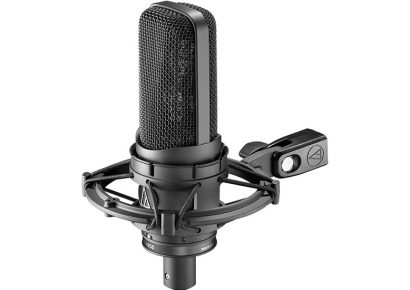The sE RNT is a large-diaphragm condenser and is the most sizeable of the three microphones. Included is a power supply with a nine-position polar pattern switch (cardioid, omni, figure eight and several other positions between each), a high-pass filter set at 40Hz or 80Hz, and a pad/gain boost at 12dB either side. A nine-pin connector with a nice long cable connects the mic to the power supply, which also includes switchable voltage. The RNT’s cradle feels solid and is highly adjustable, which is helpful as the mic is tall and weighty. The microphone itself is clean and inconspicuous looking, with a silver metal grille and sleek black body. Recording on the cardioid setting, the RNT is forward and transparent. Voices are articulate and crystal clear, with a nice proximity effect when positioned closer to the speaker or singer. Amplified electric guitar sound very true to tone when positioned close to the speaker cone of an amp, delivering an even frequency response without much colour. However, even at a distance, the mic is susceptible to breathy pops and sibilance.
The sE/RND collaboration also includes a small diaphragm condenser mic, the RN17. The RN17 is a direct, solid microphone presented in a classy wooden case. It has a tiny diaphragm that reacts well to transients, but with a larger transformer that reacts better to low frequency signals. This makes for a multifaceted microphone with laser-like focus and great side rejection, especially on figure eight and cardioid patterns. Everything feels solid, and the included mic holder leaves the RN17 suspended in a cradle to withstand bumps or anything else that might happen during recording. It’s perfect as a microphone for rooms when recording instruments or as a direct mic on anything you can throw at it (figuratively, of course. The RN17 is robust, but please don’t throw anything at it, nor throw it around a room).
The third and final mic in the series is the sE RNR1 Active Ribbon microphone. This microphone looks and sounds like a weapon, and is easily the most colourful of the series. Traditionally, ribbon microphones produce a very dark sound and don’t have much response beyond 10kHz or so, for better or worse. Enter the RNR1, a microphone that Rupert Neve and Siwei Zou first deemed “impossible”. The RNR1 is an active ribbon microphone (sending phantom power to a ribbon will never not be scary), whose frequency response reaches an amazing 25kHz (that’s 5kHz beyond the range of human hearing, for those playing at home).
What I love most about the RNR1 is that it still sounds like a ribbon mic. The high frequency response is detailed and articulate, but the overall sound still feels smooth and treated like any other ribbon microphone would. Instead of feeling like the top end has been rolled off, the RNR1 has been meticulously EQ’d for precision and detail. It sounds and feels to me like a Royer 121, but a little less meaty and with more detail. Similar to the famous 121, the mids of the RNR1 are present and forward without being overbearing, meaning this mic would be at home on guitar or bass cabs, a grand piano, a jazz trio, etc. Literally any signal would benefit from the RNR1, whether direct or as a roomy microphone.
The SE/Rupert Neve Signature Series can handle anything. Whether used alone or in stereo pairs, all three of these microphones can handle the high SPL of modern sounds and tones, but can be equally deadly with more sensitive signals. The RNT is a reimagined and refined take on a classic design of a large diaphragm condenser, while the RNR1 active ribbon and RN17 small diaphragm condenser models are pushing the envelope for what, how and why microphones are chosen for certain sources.

